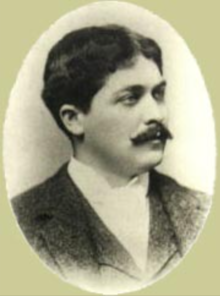A. C. Schweinfurth
Albert Cicero Schweinfurth | |
|---|---|
 | |
| Born | January 7, 1863 |
| Died | September 27, 1900 (aged 37) |
| Occupation | Architect |
| Relatives |
|
| Buildings | First Unitarian Church, Moody house, Hacienda del Pozo de Verona |
A. C. Schweinfurth (1864–1900), born Albert Cicero Schweinfurth, was an American architect.[1] He is associated with the First Bay Tradition, an architectural style from the period of the 1880s to early 1920s.[2]
Early life[edit]
Schweinfurth was the son of a German woodcarver who had immigrated to the United States a decade before his son Albert was born. His brothers Charles, Julius, and Henry also practiced in the architectural profession.
Career[edit]


Schweinfurth began his career in 1879. For the next decade he worked as a draftsman for various firms in Boston, Cleveland, New York, and Denver. In 1890, he moved to San Francisco and took a position as Chief Draftsman in the offices of A. Page Brown.[4]
In 1894, Schweinfurth established his own architectural practice under the patronage of William Randolf Hearst.[4] His Hacienda del Pozo de Verona (1894–1898), built for Phoebe Apperson Hearst in Pleasanton, was one of the first American buildings to incorporate features of Pueblo Revival architecture.[4][5]
Schweinfurth also designed the First Unitarian Church, a "landmark in the history of Bay Area architecture"[6] (1898), on the University of California, Berkeley campus.[7]
Schweinfurth designed the Dutch house Weltevreden located at 1755 Le Roy Avenue, Berkeley, California, also known as Moody House and later as Tellefsen Hall.[8]
Death[edit]
In 1898, Schweinfurth embarked on a two-year tour of Italy and France with his wife, Fanny, and their seven-year-old daughter.[7] Shortly after returning to the United States, he suffered an attack of typhoid fever. He died on September 27, 1900, in Dryden, N.Y.[9][10]
References[edit]
- ^ "A. C. Schweinfurth". Great Buildings. Berkeley, California. 1898. Retrieved 2023-06-24.
- ^ Brown, Mary (September 30, 2010). "San Francisco Modern Architecture and Landscape Design 1935–1970 Historic Context Statement" (PDF). California Office of Historic Preservation. p. 83. Retrieved 16 August 2011.
- ^ Betty Marvin (April 24, 1981). "National Register of Historic Places Inventory/Nomination: First Unitarian Church / 2401 Bancroft; University Dance Studio". National Park Service. and accompanying 10 photos from 1981 and a 1906 postcard
- ^ a b c Thompson, Daniella (May 21, 2009). "East Bay Then and Now: A Viennese Epicure in the Athens of the West". Berkeley Daily Planet. Berkeley, California. Retrieved 2015-08-23.
- ^ Canizaro, Vincent B. (2012-03-20). Architectural Regionalism: Collected Writings on Place, Identity, Modernity, and Tradition. Chronicle Books. p. 198. ISBN 9781616890803.
- ^ Gebhard and Winter, A Guide to Architecture in San Francisco and Northern California, Peregrine Smith Books, Salt Lake City, UT, 1985, p. 272
- ^ a b Thompson, Daniella (May 14, 2009). "East Bay, Then and Now: Schweinfurth's First Unitarian: A Powerhouse of a Church". Berkeley Daily Planet. Berkeley, California. Retrieved 2015-08-23.
- ^ Daniella Thompson. "Weltevreden". Berkely Landmarks. Berkeley, CA. Retrieved 24 June 2023.
- ^ Death notice. San Francisco Call, October 10, 1900, p. 11.
- ^ "Well-Known Architect Is Removed by Death". San Francisco Call, October 10, 1900, p. 12.
